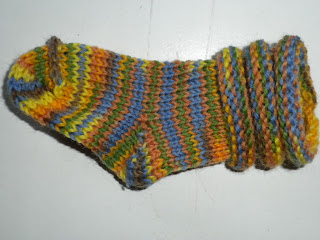 |
| Sharon's preferred, asymetrical style wrap |
 |
Note: the scarf in the pic is an early version. When you follow
the directions below, you will wind up with a longer, narrower, and
easier to wrap, scarf. You'll see, and you'll like it. |
I had a great time today at the Adirondack Museum in Blue Mountain Lake. It was Fiber Festival day, and the yarn bombers had visited the museum! There were knitting and crocheting (and felting, quilting, rug hooking, and on and on...) explosions all over the place.
I brought the boomerang to share with the other knitters, and I just enjoyed the knitting and sharing and meeting people.
The Boomerang scarf is an easy, warm and stylish scarf. It is all garter stitch, so it wraps like a dream, and wants to hold onto your coat! Knit it in wool, or a wool-silk blend. Wool-alpaca would also work, and the alpaca will lend its drapiness as well. Handspun yarn works well with this pattern. Gauge is not critical. Make it as small, or as big as you want (or as your ball of yarn dictates.)
You can knit this at bigger gauges for a softer, less structured knit. It will 'collapse' on your neck better at bigger gauge, and it will 'stand up' better at the tighter gauges.
Let me know how yours turns out.
Directions:
Boomerang Scarf
Yarn- About 200 yards
Needles to knit at about 5 stitches to the inch ( for knitting worsted weight yarn) or 6 stitches to the inch ( for sport weight yarn).
Cast on 2 stitches.
Row 1 (and all odd rows) Yarn Over, then knit to the end of the row. (increase of
one stitch)
Row 2 YO, knit to end of row. (one stitch increased)
Row 4 Same as row 2
Row 6 Bind off 4 stitches, knit to end of row.
Repeat these 6 rows until you have used about half of your yarn.
Then:
Row 1 (and all odd rows) YO, K1, YO, knit to end of row (2 stitches increased)
Row 2, 4, and 6 as before.
When 15 or 20 yards of yarn remain, end row 5.
Then:
Row 1 Bind off 4, knit 5, turn.
Row 2 K 5, turn
Row 3 K 6, turn
Row 4 K 6, turn
Row 5 K 7, turn
Row 6 K 7, turn
Repeat these 6 rows to make sawteeth and bind off the open stitches. If you run short of yarn before sawteeth are done, bind off the rest of the open stitches without making sawteeth.








































